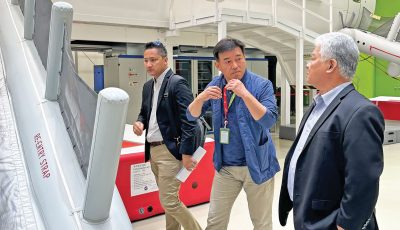Unmanned weapons of war: How war may be fought in our Pacific Ocean backyard
Gone are the days of a Navy, Marine Corps, and Air Force that require 100% human piloting for ship driving, tactical land, and air operations. The Pentagon is headed down the path of having to adapt to preparing for war using more and more unmanned weapons of war like never before. This trend translates into weapons of the future using more and more artificial intelligence, high technology, and resources to help build out thousands of operationally-proven armed drones, unmanned aircraft, submarines, and surface ships.
The laydown of American military forces in Guam and the CNMI is predicated on the idea that war is going to be a massive hot and deadly undertaking where thousands of people, if not more, die. Perhaps the assumption that thousands will die is not entirely accurate because disabling key infrastructure nodes can and will cripple an economy, whether it is Guam, Hawaii, California or elsewhere.
Prosecution of future war will require that satellites orbiting the Earth will be fully operational and functional. If space-based networks are not fully functional and operational, 21st century war may be severely hampered.
The American Navy at it once again
The U.S. Navy has been quite adept at ensuring that it stays as relevant as possible when it comes to preparing for future warfare. The Navy has also produced major flops when it comes to constructing manned surface combat vessels over the past two decades. The Littoral Combat Ship program provides one example with ample evidence of just how bad Navy shipbuilding oversight and management can get when it comes to properly managing American taxpayer funds to build out a military surface vessel inventory and fleet.
Yet the Navy is also moving to adapt to a peer competitor environment as quickly as it can. It is now systematically building out an unmanned fleet of weapons for war. It needs it more than ever because China is already far into its military modernization and expansion work.
The Navy established an unmanned surface vessel organization intended to work with allies worldwide. The Marine Corps is working alongside the Navy on this front. Both organizations are trying to expand the digital architecture required to transform how the Navy and Marine Corps organizations train, prepare, and fight future wars. The top leaders in the Marine Corps seek to fully transform how they conduct business by 2030. Time will tell how successful current Marine Corps efforts will ultimately be.
Autonomous systems are the wave of the future
The Pentagon is doing everything it can to reconstitute and move toward autonomous unmanned systems. This is being done to further improve how the Navy and Marine Corps distribute warfighting resources. These systems are to be used in the air, sea, and land domains. Unlike traditional weapons systems, autonomous systems require software upgrades, massive and complicated computer algorithms, but not necessarily massive hardware upgrades. Unmanned autonomous systems require human involvement to fully operate as well.
Unmanned weapons systems—restated differently
The Navy and Marine Corps want to have suites of weapons that can be used, shot, and deployed from greater physical distances that have better accuracy and are faster. This is especially important in fighting in the Deep Blue Pacific Ocean continent. The reason technology and technology applications are so important is that they are key enablers that convert ideas into reality. Technological changes will also present the Pentagon with opportunities and challenges to continuously improve upon the capacity of weapons systems sensors to help and assist the Navy and Marine Corps toward being able to prosecute and win war.
The Navy and Army are using lasers to shoot down missiles. The Pentagon is moving quickly to field an array of hypersonic speed weapons platforms that have instilled greater cooperation between the Navy and Army.
Aerial drones are currently in the hands of approximately 100 countries. Drones can carry precision guided missiles and are much cheaper than buying a fancy fighter jet. Drones enable non-state actors the opportunity to inflict harm on targeted adversaries. Thus the Pentagon is incentivized to spend more and more money and focus on drone warfare, with the intent to more fully utilize, exploit and manage technological developments as they evolve.
Our Chamorro Pacific Islander civilization and another opportunity to learn from the ongoing balance of power competition taking place between China and America
The China-U.S. competition is complex, nuanced, and substantial. Both the United States and China have levels of economic interdependence with each other that dissuades either country from declaring war on the other. China does billions of dollars of business with a host of American allies in Asia, while the United States continues to seek to further expand economic relationships with its constellation of allies. Both China and the United States also have nuanced diplomatic relationships with each other that emphasizes cooperation and coercion on a variety of fronts.
These complex relationships remain intact as both China and the U.S. also prepare to go to war with one another. As unmanned weapons systems proliferate, the ability of military commanders and operators to identify and track key military targets will become more and more important. Over time it will also become more important for military personnel figure out how to decide to either engage a target or not.
All these point to the need to revisit the importance of human wisdom and human decision-making limitations, especially in a future warfighting environment where humans may simply not be able to make split second decisions related to hypersonic weapons warfare. Yes, all this relates to Guam, the Northern Mariana Islands, and our broader western Pacific Ocean region of the world.



























